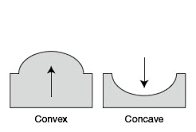Results 1 to 10 of 28
Threaded View
-
09-25-2015, 10:51 PM #18Senior Member



- Join Date
- Apr 2012
- Location
- Diamond Bar, CA
- Posts
- 6,553
Thanked: 3215
Perhaps the confusion is that honing a Smiling razor is different than honing a Warped razor, (Concave/Convex), while both use the same stroke.
The Wiki shows Russel demonstrating honing for both issues using the same stroke,(two different sets of photos), a Warped razor, Concave side with the heel off the stone. The same stroke will work for smiling or warped razors, but only the top series of photos will work for the Concave side of a warped razor.
The second series of photos, that Russel calls the Rolling Hone is the same stroke Charlie is using in his video on a Smiling Razor. It will not work on the Concave side of a Warped razor, but will with Smiling and Convex side or a warped razor.
The spine has to be on the stone the whole time to get a consistent angle, just not the complete spine at the same time, for a smiling edge or a warped spine.
For a warped razor, the Convex Side uses the standard rolling X, rolling or lifting the heel end up, as the razor makes contact, down the middle of the stone. This is the same stroke as a Smiling razor, (Charlie’s video)
The concave side, hones on the half of the stone closest to where the X will finish, so that the heel and corresponding spine, come off the stone and allows the bevel to ride on only half or a small portion of the stone near the edge. The heel and corresponding part of the spine has to come off the stone for the center part of the bevel to make contact, rolling is down, not up, off the edge and away from the stone, on that side.
It is the same stroke, on different parts of the stone, with a different objective for different issues.
The Wiki is fine, just difficult to explain, demonstrating, two different issues, using the same stroke on different parts of the stone. If we could see the water in the photos you would see, where the bevel and edge are making contact.
This might help...

Last edited by Euclid440; 09-25-2015 at 10:59 PM.
-
The Following 2 Users Say Thank You to Euclid440 For This Useful Post:
Hirlau (09-26-2015), Razorfaust (09-25-2015)


 14Likes
14Likes LinkBack URL
LinkBack URL About LinkBacks
About LinkBacks






 Reply With Quote
Reply With Quote